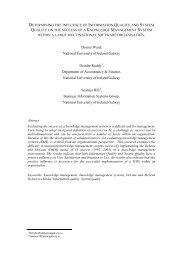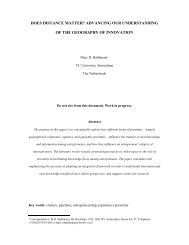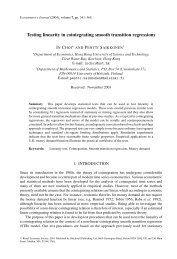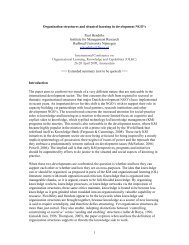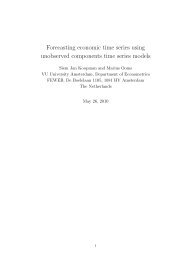The effects of road pricing - Feweb - Vrije Universiteit Amsterdam
The effects of road pricing - Feweb - Vrije Universiteit Amsterdam
The effects of road pricing - Feweb - Vrije Universiteit Amsterdam
Create successful ePaper yourself
Turn your PDF publications into a flip-book with our unique Google optimized e-Paper software.
2.2 Transport <strong>pricing</strong><br />
Pricing is a method <strong>of</strong> resource allocation. Pricing strategies permit specified aims to<br />
be achieved; there is no such thing as the ‘right’ price. <strong>The</strong> <strong>pricing</strong> policy adopted by<br />
any transport undertaking depends upon its basic objectives. For example, optimal<br />
price aimed at achieving pr<strong>of</strong>it maximisation may differ from that needed to maximise<br />
social welfare or to ensure the highest sales revenue. In some cases, there is no<br />
attempt to devise a price to maximise or minimise anything, but instead prices are set<br />
that permit lower level objectives (for example, security, minimum market share) to<br />
be attained. Further, prices may be set to achieve certain objectives for the transport<br />
supplier in terms <strong>of</strong> his welfare. This is normally the case for private enterprise<br />
transport undertakings, while in other areas prices may be set to improve the welfare<br />
<strong>of</strong> consumers (as has been the case with publicly-owned transport undertakings). This<br />
distinction is important, as many undertakings consider that the employment <strong>of</strong> the<br />
<strong>pricing</strong> mechanisms to achieve their objectives is automatically for the benefit <strong>of</strong><br />
customers.<br />
It is clear that <strong>pricing</strong> objectives differ, depending on the provision <strong>of</strong> transport<br />
services (public or private) and market conditions. <strong>The</strong> following <strong>pricing</strong> objectives<br />
can be distinguished:<br />
• Economic efficiency;<br />
• Pr<strong>of</strong>it maximisation;<br />
• Cost coverage;<br />
• Environmental sustainability;<br />
• Equity (including redistributive objectives);<br />
• Objectives transcending the boundaries <strong>of</strong> transport markets, including<br />
macroeconomic objectives.<br />
<strong>The</strong> objective <strong>of</strong> economic efficiency reflects the aim to maximise social welfare; this<br />
will be discussed in Section 2.3. Pr<strong>of</strong>itability is the traditional, classical economic<br />
assumption that firms set prices as to maximise pr<strong>of</strong>its. More recent variations on this<br />
theory suggest that many undertakings adopt prices that maximise sales revenues<br />
(Baumol, 1962) when in an expansive phase, or simply price to ensure that certain<br />
satisfactory levels <strong>of</strong> pr<strong>of</strong>it or market domination are achieved (Simon, 1959). A third<br />
possible objective is that <strong>of</strong> cost coverage. Most publicly-owned firms are focused not<br />
so much on making pr<strong>of</strong>its but to stay in business and recoup their costs, <strong>of</strong>ten<br />
induced to do so for political or fiscal reasons. Protection <strong>of</strong> the environment has<br />
become an important objective for governments in recent years. Transport in general,<br />
and <strong>road</strong> transport in particular, are widely recognised as an important source <strong>of</strong><br />
pollution which threatens environmental sustainability. Pricing measures have been<br />
suggested or introduced to deal with these problems. Promoting environmental<br />
objectives may be consistent with the aim <strong>of</strong> securing welfare maximisation through<br />
economic efficiency, in particular when social welfare incorporates environmental<br />
social costs and benefits.<br />
Equity objectives and the distribution <strong>of</strong> real incomes in society are important issues<br />
for a government, reflected in the pattern <strong>of</strong> taxation and public expenditures. Whilst<br />
transfer payments, such as benefits and pensions, are a major means <strong>of</strong> redistributing<br />
income, the provision <strong>of</strong> services, such as transport at subsidised prices, is <strong>of</strong>ten<br />
considered to be equally important (United Nations, 2001). Moreover, tax policies (or<br />
other policies) aimed at regulating transport and revenue recycling, will have<br />
distributional consequences that may or may not match more generally formulated<br />
distributional targets, and may therefore motivate adjustments in currently used<br />
10





